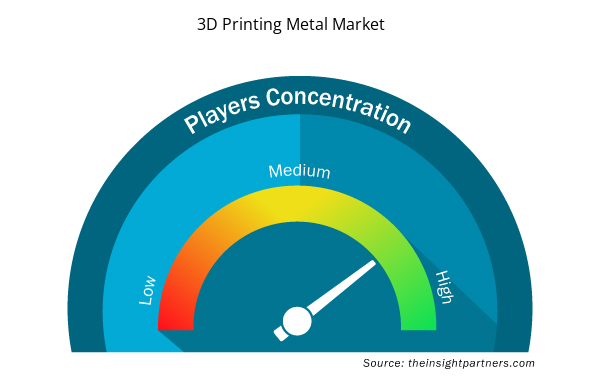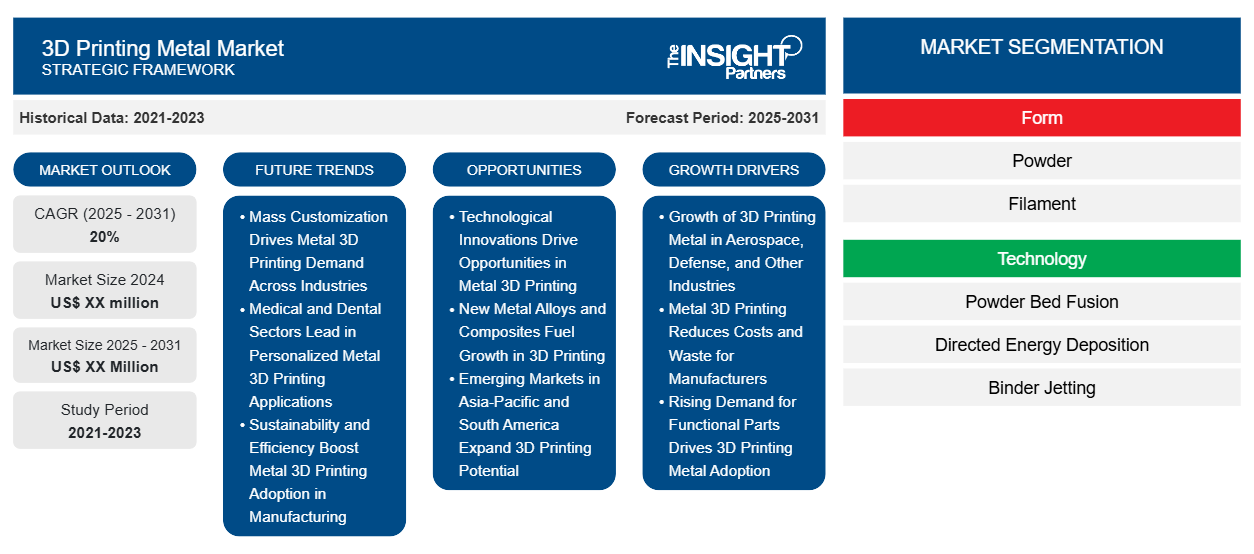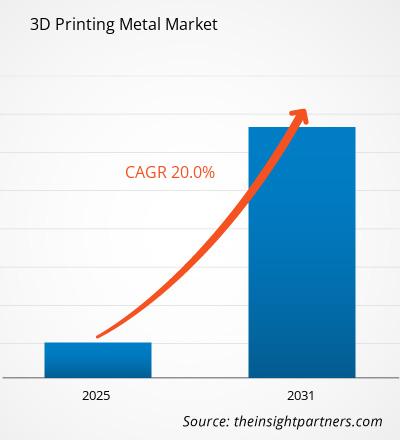Es wird erwartet, dass der Markt für 3D-Druckmetalle von 2024 bis 2031 eine durchschnittliche jährliche Wachstumsrate (CAGR) von 20 % verzeichnet, wobei die Marktgröße von XX Millionen US-Dollar im Jahr 2024 auf XX Millionen US-Dollar im Jahr 2031 anwachsen wird.
Der Marktbericht zum 3D-Druck von Metall ist nach Form (Pulver und Filament) segmentiert. Der Bericht enthält außerdem eine Analyse basierend auf der Technologie (Pulverbettfusion, gerichtete Energieabscheidung, Binder Jetting, Metallextrusion und andere). Der Bericht ist nach Metallart (Titan, Nickel, Edelstahl, Aluminium und andere) segmentiert. Der Bericht wird auch basierend auf der Endverbrauchsbranche (Luftfahrt und Verteidigung, Automobil, Medizin und andere) analysiert. Die globale Analyse wird weiter auf regionaler Ebene und in den wichtigsten Ländern aufgeschlüsselt. Die Marktgröße und -prognose auf globaler, regionaler und Länderebene für alle wichtigen Marktsegmente werden im Rahmen des Berichts abgedeckt. Der Bericht bietet den Wert in USD für die oben genannte Analyse und die Segmente.
Zweck des Berichts
Der Bericht „3D Printing Metal Market“ von The Insight Partners soll die aktuelle Landschaft und das zukünftige Wachstum sowie die wichtigsten treibenden Faktoren, Herausforderungen und Chancen beschreiben. Dies wird verschiedenen Geschäftspartnern Einblicke geben, wie zum Beispiel:
- Technologieanbieter/-hersteller: Um die sich entwickelnde Marktdynamik zu verstehen und die potenziellen Wachstumschancen zu kennen, damit sie fundierte strategische Entscheidungen treffen können.
- Investoren: Durchführung einer umfassenden Trendanalyse hinsichtlich der Marktwachstumsrate, der finanziellen Marktprognosen und der Chancen entlang der Wertschöpfungskette.
- Regulierungsbehörden: Zur Regulierung von Richtlinien und Überwachungsaktivitäten auf dem Markt mit dem Ziel, Missbrauch zu minimieren, das Vertrauen der Anleger zu bewahren und die Integrität und Stabilität des Marktes aufrechtzuerhalten.
3D-Druck von Metall Marktsegmentierung
Bilden
- Pulver
- Filament
Technologie
- Pulverbettfusion
- Gerichtete Energieabscheidung
- Binder Jetting
- Metallextrusion
Endverbrauchsindustrie
- Luft- und Raumfahrt und Verteidigung
- Automobilindustrie
- Medizin
Metallart
- Titan
- Nickel
- Edelstahl
- Aluminium
Passen Sie diesen Bericht Ihren Anforderungen an
Sie erhalten kostenlose Anpassungen an jedem Bericht, einschließlich Teilen dieses Berichts oder einer Analyse auf Länderebene, eines Excel-Datenpakets sowie tolle Angebote und Rabatte für Start-ups und Universitäten.
- Holen Sie sich die wichtigsten Markttrends aus diesem Bericht.Dieses KOSTENLOSE Beispiel umfasst eine Datenanalyse von Markttrends bis hin zu Schätzungen und Prognosen.
Wachstumstreiber für den 3D-Druck von Metall
- Wachstum von 3D-Druckmetall in der Luft- und Raumfahrt, der Verteidigung und anderen Branchen: Der Markt für 3D-Druckmetalle verzeichnet ein signifikantes Wachstum, das von verschiedenen Faktoren in mehreren Branchen wie der Luft- und Raumfahrt und Verteidigung, der Automobilindustrie, der Medizin- und Zahnmedizin und anderen angetrieben wird. Die Luft- und Raumfahrt und die Verteidigung sind die größten Verbraucher von 3D-Druckmetall, da es für Prototypen, Endverbrauchsteile und sogar schnelle Ersatzteile verwendet wird. Der Bedarf an Hochleistungsmaterialien, beispielsweise solchen mit extremen Einsatzbedingungen wie Titan oder Aluminium, treibt das Wachstum dieses Sektors stark an.
- 3D-Druck mit Metall reduziert Kosten und Abfall für Hersteller: Hersteller profitieren vom 3D-Druck mit Metall aufgrund der geringeren Herstellungskosten und minimalen Vorlaufzeiten bei gleichzeitig minimalem Abfall am Produktionsort. Diese Eigenschaft ist für viele Hersteller attraktiv, die ihre Prozesse effizienter gestalten möchten.
- Steigende Nachfrage nach Funktionsteilen treibt die Einführung des 3D-Drucks für Metall voran: Die Nachfrage nach Funktionsteilen, insbesondere in Fertigungsindustrien wie der Automobil- und Luftfahrtindustrie, wird zum wichtigsten Wachstumstreiber. Unternehmen aus verschiedenen Branchen wie der Luft- und Raumfahrt, Verteidigung, Automobilindustrie und Medizin verwenden zunehmend den 3D-Druck, um Teile herzustellen, die bestimmte Leistungskriterien erfüllen.
Zukünftige Trends auf dem 3D-Druck-Metallmarkt
- Massenanpassung treibt die Nachfrage nach 3D-Metalldruck branchenübergreifend an: Es gibt einen wachsenden Trend zur Massenanpassung. Unternehmen nutzen den 3D-Metalldruck, um etwas herzustellen, das speziell auf einen einzelnen Kunden zugeschnitten ist. In vielen Branchen, darunter Medizin und Luft- und Raumfahrt, steigt die Nachfrage nach personalisierteren Produkten.
- Der medizinische und zahnmedizinische Sektor ist führend bei personalisierten 3D-Druckanwendungen für Metall: Die medizinische und zahnmedizinische Industrie ist einer der wichtigsten Märkte, in denen 3D-Druck für maßgeschneiderte Implantate und Zahnersatz eingesetzt wird. Personalisierte medizinische Lösungen werden mit Sicherheit zunehmen und dies wird höchstwahrscheinlich ein neuer Trend werden.
- Nachhaltigkeit und Effizienz fördern die Einführung des 3D-Drucks mit Metallen in der Fertigung: Ein weiterer Trend auf dem Markt ist ein wachsender Fokus auf kürzere Fertigungs- und Vorlaufzeiten sowie Abfallreduzierung, die der 3D-Druck mit Metallen von Natur aus bietet. Verschiedene Branchen werden nach nachhaltigeren Fertigungsverfahren suchen und daher in der Effizienz von 3D-Drucktechnologien für Metalle Marktwachstum finden. Außerdem wird es eine starke Nachfrage nach Prototyping-Anwendungen geben, da verschiedene Unternehmen diese Technologie benötigen, um schnell und kostengünstig komplexe Metallprototypen herzustellen und zu entwickeln.
Marktchancen für 3D-Druck von Metall
- Technologische Innovationen eröffnen Chancen im 3D-Metalldruck: Die technologischen Innovationen werden im Prognosezeitraum voraussichtlich lukrativere Chancen für den 3D-Metalldruckmarkt bieten. Durch die Weiterentwicklung von Forschung und Entwicklung ergeben sich Möglichkeiten bei der Untersuchung und Kommerzialisierung neuer, effizienter und zuverlässiger 3D-Metalldrucktechnologien.
- Neue Metalllegierungen und Verbundwerkstoffe treiben das Wachstum im 3D-Druck voran: Die Entwicklung neuer Metalllegierungen und Verbundwerkstoffe, die speziell für den 3D-Druck entwickelt wurden, wird weitere Wachstumschancen bieten. Neuartige Materialwissenschaften mit stärkeren, leichteren und haltbareren Teilen werden eingesetzt, um eine hervorragende Leistung bei gedruckten Teilen für die Luft- und Raumfahrt sowie den Automobilbereich zu erzielen. Verschiedene Akteure auf dem Markt konzentrieren sich auch auf Investitionen in Forschungs- und Entwicklungsaktivitäten, um neue, innovative und qualitativ hochwertige Produkte anzubieten, die die Kundennachfrage erfüllen.
- Schwellenmärkte im asiatisch-pazifischen Raum und in Südamerika erweitern das 3D-Druckpotenzial: Darüber hinaus gewinnen Schwellenregionen wie der asiatisch-pazifische Raum und Südamerika in der 3D-Druck-Metalllandschaft zunehmend an Bedeutung. Diese Regionen bieten Unternehmen oft enorme Möglichkeiten, sich dort niederzulassen und von der wachsenden Nachfrage nach High-End-Fertigungslösungen zu profitieren.
Regionale Einblicke in den 3D-Druckmetallmarkt
Die regionalen Trends und Faktoren, die den Markt für 3D-Druckmetalle während des gesamten Prognosezeitraums beeinflussen, wurden von den Analysten von Insight Partners ausführlich erläutert. In diesem Abschnitt werden auch die Marktsegmente und die Geografie für 3D-Druckmetalle in Nordamerika, Europa, im asiatisch-pazifischen Raum, im Nahen Osten und Afrika sowie in Süd- und Mittelamerika erörtert.

- Erhalten Sie regionale Daten zum 3D-Druck von Metallen
Umfang des Marktberichts zum 3D-Druck von Metall
| Berichtsattribut | Details |
|---|---|
| Marktgröße im Jahr 2024 | XX Millionen US-Dollar |
| Marktgröße bis 2031 | XX Millionen US-Dollar |
| Globale CAGR (2025 - 2031) | 20 % |
| Historische Daten | 2021-2023 |
| Prognosezeitraum | 2025–2031 |
| Abgedeckte Segmente | Nach Formular
|
| Abgedeckte Regionen und Länder | Nordamerika
|
| Marktführer und wichtige Unternehmensprofile |
|
Dichte der Marktteilnehmer für 3D-Druck aus Metall: Die Auswirkungen auf die Geschäftsdynamik verstehen
Der Markt für 3D-Druckmetalle wächst rasant, angetrieben durch die steigende Nachfrage der Endnutzer aufgrund von Faktoren wie sich entwickelnden Verbraucherpräferenzen, technologischen Fortschritten und einem größeren Bewusstsein für die Vorteile des Produkts. Mit steigender Nachfrage erweitern Unternehmen ihr Angebot, entwickeln Innovationen, um die Bedürfnisse der Verbraucher zu erfüllen, und nutzen neue Trends, was das Marktwachstum weiter ankurbelt.
Die Marktteilnehmerdichte bezieht sich auf die Verteilung von Firmen oder Unternehmen, die in einem bestimmten Markt oder einer bestimmten Branche tätig sind. Sie gibt an, wie viele Wettbewerber (Marktteilnehmer) in einem bestimmten Marktraum im Verhältnis zu seiner Größe oder seinem gesamten Marktwert präsent sind.
Die wichtigsten Unternehmen auf dem Markt für 3D-Druckmetalle sind:
- Stratasys
- CRS Holdings, LLC.
- Materialisieren
- Sandvik AB
- Höganäs AB
Haftungsausschluss : Die oben aufgeführten Unternehmen sind nicht in einer bestimmten Reihenfolge aufgeführt.

- Überblick über die wichtigsten Akteure auf dem Markt für 3D-Druckmetalle
Wichtige Verkaufsargumente
- Umfassende Abdeckung: Der Bericht deckt die Analyse der Produkte, Dienste, Typen und Endbenutzer des 3D-Druckmetallmarktes umfassend ab und bietet einen ganzheitlichen Überblick.
- Expertenanalyse: Der Bericht basiert auf dem umfassenden Verständnis von Branchenexperten und Analysten.
- Aktuelle Informationen: Der Bericht stellt durch die Abdeckung aktueller Informationen und Datentrends Geschäftsrelevanz sicher.
- Anpassungsoptionen: Dieser Bericht kann angepasst werden, um spezifische Kundenanforderungen zu erfüllen und die Geschäftsstrategien optimal anzupassen.
Der Forschungsbericht zum Markt für 3D-Druckmetalle kann daher dabei helfen, die Branchensituation und Wachstumsaussichten zu entschlüsseln und zu verstehen. Obwohl es einige berechtigte Bedenken geben kann, überwiegen die allgemeinen Vorteile dieses Berichts tendenziell die Nachteile.
- Historische Analyse (2 Jahre), Basisjahr, Prognose (7 Jahre) mit CAGR
- PEST- und SWOT-Analyse
- Marktgröße Wert/Volumen – Global, Regional, Land
- Branche und Wettbewerbsumfeld
- Excel-Datensatz



Report Coverage
Revenue forecast, Company Analysis, Industry landscape, Growth factors, and Trends

Segment Covered
This text is related
to segments covered.

Regional Scope
North America, Europe, Asia Pacific, Middle East & Africa, South & Central America

Country Scope
This text is related
to country scope.
Häufig gestellte Fragen
Based on geography, Europe held the largest share of the 3D printing metal market due to the well-established automotive and aerospace industry across the region.
Based on end-use industry, the aerospace and defense segment is expected to witness the fastest growth during the forecast period
ATI, Colibrium Additive, CRS Holdings LLC, GKN Powder Metallurgy, Kennametal Inc, Materialise NV, Sandvik, CNPC Powders, Höganäs AB, and INDO-MIM are some of the key players operating in the 3D printing metal market
Rising demand for 3D printing metals from the automotive and aerospace industry are driving the market growth
The 3D Printing Metal Market is estimated to witness a CAGR of 20% from 2023 to 2031
Rising demand for the customized products is expected to be the key market trends
Trends and growth analysis reports related to Chemicals and Materials : READ MORE..
The List of Companies
- Stratasys
- CRS Holdings, LLC.
- Materialise
- Sandvik AB
- Höganäs AB
- EOS
- Desktop Metal, Inc.
- SLM Solutions
- Sculpteo
- Markforged
The Insight Partners performs research in 4 major stages: Data Collection & Secondary Research, Primary Research, Data Analysis and Data Triangulation & Final Review.
- Data Collection and Secondary Research:
As a market research and consulting firm operating from a decade, we have published and advised several client across the globe. First step for any study will start with an assessment of currently available data and insights from existing reports. Further, historical and current market information is collected from Investor Presentations, Annual Reports, SEC Filings, etc., and other information related to company’s performance and market positioning are gathered from Paid Databases (Factiva, Hoovers, and Reuters) and various other publications available in public domain.
Several associations trade associates, technical forums, institutes, societies and organization are accessed to gain technical as well as market related insights through their publications such as research papers, blogs and press releases related to the studies are referred to get cues about the market. Further, white papers, journals, magazines, and other news articles published in last 3 years are scrutinized and analyzed to understand the current market trends.
- Primary Research:
The primarily interview analysis comprise of data obtained from industry participants interview and answers to survey questions gathered by in-house primary team.
For primary research, interviews are conducted with industry experts/CEOs/Marketing Managers/VPs/Subject Matter Experts from both demand and supply side to get a 360-degree view of the market. The primary team conducts several interviews based on the complexity of the markets to understand the various market trends and dynamics which makes research more credible and precise.
A typical research interview fulfils the following functions:
- Provides first-hand information on the market size, market trends, growth trends, competitive landscape, and outlook
- Validates and strengthens in-house secondary research findings
- Develops the analysis team’s expertise and market understanding
Primary research involves email interactions and telephone interviews for each market, category, segment, and sub-segment across geographies. The participants who typically take part in such a process include, but are not limited to:
- Industry participants: VPs, business development managers, market intelligence managers and national sales managers
- Outside experts: Valuation experts, research analysts and key opinion leaders specializing in the electronics and semiconductor industry.
Below is the breakup of our primary respondents by company, designation, and region:

Once we receive the confirmation from primary research sources or primary respondents, we finalize the base year market estimation and forecast the data as per the macroeconomic and microeconomic factors assessed during data collection.
- Data Analysis:
Once data is validated through both secondary as well as primary respondents, we finalize the market estimations by hypothesis formulation and factor analysis at regional and country level.
- Macro-Economic Factor Analysis:
We analyse macroeconomic indicators such the gross domestic product (GDP), increase in the demand for goods and services across industries, technological advancement, regional economic growth, governmental policies, the influence of COVID-19, PEST analysis, and other aspects. This analysis aids in setting benchmarks for various nations/regions and approximating market splits. Additionally, the general trend of the aforementioned components aid in determining the market's development possibilities.
- Country Level Data:
Various factors that are especially aligned to the country are taken into account to determine the market size for a certain area and country, including the presence of vendors, such as headquarters and offices, the country's GDP, demand patterns, and industry growth. To comprehend the market dynamics for the nation, a number of growth variables, inhibitors, application areas, and current market trends are researched. The aforementioned elements aid in determining the country's overall market's growth potential.
- Company Profile:
The “Table of Contents” is formulated by listing and analyzing more than 25 - 30 companies operating in the market ecosystem across geographies. However, we profile only 10 companies as a standard practice in our syndicate reports. These 10 companies comprise leading, emerging, and regional players. Nonetheless, our analysis is not restricted to the 10 listed companies, we also analyze other companies present in the market to develop a holistic view and understand the prevailing trends. The “Company Profiles” section in the report covers key facts, business description, products & services, financial information, SWOT analysis, and key developments. The financial information presented is extracted from the annual reports and official documents of the publicly listed companies. Upon collecting the information for the sections of respective companies, we verify them via various primary sources and then compile the data in respective company profiles. The company level information helps us in deriving the base number as well as in forecasting the market size.
- Developing Base Number:
Aggregation of sales statistics (2020-2022) and macro-economic factor, and other secondary and primary research insights are utilized to arrive at base number and related market shares for 2022. The data gaps are identified in this step and relevant market data is analyzed, collected from paid primary interviews or databases. On finalizing the base year market size, forecasts are developed on the basis of macro-economic, industry and market growth factors and company level analysis.
- Data Triangulation and Final Review:
The market findings and base year market size calculations are validated from supply as well as demand side. Demand side validations are based on macro-economic factor analysis and benchmarks for respective regions and countries. In case of supply side validations, revenues of major companies are estimated (in case not available) based on industry benchmark, approximate number of employees, product portfolio, and primary interviews revenues are gathered. Further revenue from target product/service segment is assessed to avoid overshooting of market statistics. In case of heavy deviations between supply and demand side values, all thes steps are repeated to achieve synchronization.
We follow an iterative model, wherein we share our research findings with Subject Matter Experts (SME’s) and Key Opinion Leaders (KOLs) until consensus view of the market is not formulated – this model negates any drastic deviation in the opinions of experts. Only validated and universally acceptable research findings are quoted in our reports.
We have important check points that we use to validate our research findings – which we call – data triangulation, where we validate the information, we generate from secondary sources with primary interviews and then we re-validate with our internal data bases and Subject matter experts. This comprehensive model enables us to deliver high quality, reliable data in shortest possible time.


 Holen Sie sich ein kostenloses Muster für diesen Bericht
Holen Sie sich ein kostenloses Muster für diesen Bericht